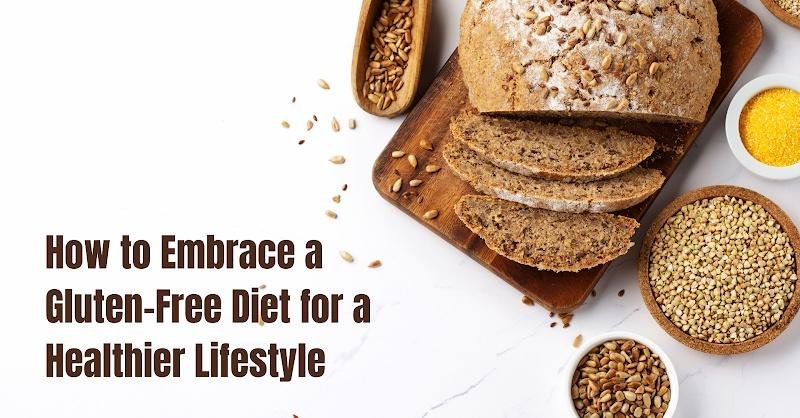For many, gluten—a protein present in many staple foods—can be a hidden trigger for health problems. While it is present in wheat, barley, and rye, it really shows up in much more of a catch-all category: processed foods.
For those with gluten sensitivity or celiac disease, taking on a gluten-free diet is a serious requirement, but it definitely appears to be daunting. In addition to managing these conditions, a gluten-free lifestyle can be healthy and beneficial for everyone. Here is how you can achieve a smooth and sustainable transition.
Understanding Gluten and Its Impact
Gluten is an elastic protein in dough responsible for letting bread rise. It’s found in most products, including bread, pasta, sauces, and soups. In people with celiac disease, this causes an autoimmune reaction in their body, which damages the small intestine, leading to symptoms such as abdominal pain, diarrhea, and fatigue. Those with gluten sensitivity may have similar symptoms, but there is no autoimmune component.
This makes for a gluten-free diet that steers clear of these issues by avoiding the foods with gluten and instead opting for those alternatives that not only promise nutrition but also provide satisfaction. Incorporating meal delivery services into a gluten-free diet can make managing these dietary restrictions easier and more convenient. A gluten free diet meal delivery service offers a variety of gluten-free options, ensuring that individuals with celiac disease or gluten sensitivity can enjoy delicious and safe meals without the hassle of preparing them from scratch
Also Read : What Is Millwork? Things You Ought To Understand About Millwork
Getting Started with a Gluten-Free Diet
Educate Yourself
The first step towards a gluten-free diet is to be in the know of which foods have gluten and which ones do not. Gluten is most commonly found in wheat, barley, and rye, but it also hides in less obvious products like sauces, dressings, and some processed foods. Reading the labels is paramount. Nowadays, many companies label their products with gluten-free certifications, making it easier to identify safe options.
Stock Your Pantry with Gluten-Free Staples
For some people, starting a gluten-free diet may be as easy as simply restocking with gluten-free staples. Here’s a list of important things to have on hand:
- Gluten-Free Grains: Rice, quinoa, buckwheat, millet, and gluten-free oats.
- Flours and Baking Mixes: Almond flour, coconut flour, rice flour, and gluten-free all-purpose baking mixes.
- Legumes and Pulses: Great sources of protein and fiber are beans, lentils, and chickpeas.
- Fruits and Vegetables: Fresh produce is, by nature, gluten-free and should form the basis of your diet.
- Proteins: Lean meats, fish, eggs, dairy products if not lactose intolerant
Learn to Cook and Bake Gluten-Free
Gluten-free cooking and baking can be an enjoyable, creative activity. Most conventional recipes can be easily converted and cooked, quite acceptably, with gluten-free ingredients. Here are some tips:
- Use gluten-free flour blends since they are specifically formulated to replicate wheat flour, performing well in most recipes.
- New ingredients can be tried, like almond flour, coconut flour, and chia seeds. They offer unique flavors and textures for a wide array of dishes.
- Explore gluten-free recipes; thousands are available online for bread, cookies, cakes, and more. Try them to see what you will like.
Explore Gluten-Free Meal Options
Eating out can be a bit of a challenge when one is on a gluten-free diet, but nowadays, many restaurants accommodate gluten-free requests. Always mention your gluten intolerance when dining out to avoid contamination. Here are some meal ideas to get you started:
- Breakfast: Greek yogurt with fresh fruit and gluten-free granola, or a smoothie made with gluten-free protein powder and fruits.
- Lunch: Quinoa and mixed vegetable salad with lemon vinaigrette, or gluten-free wrap with lean turkey, avocado, greens.
- Dinner: Grilled salmon and roasted sweet potatoes with steamed broccoli. Gluten-free pasta with marinara sauce and side salad
- Snacks: Fresh fruit, nuts, gluten-free rice cakes, or veggie sticks with hummus.
Understand Cross-Contamination
One of the major concerns in the case of gluten-free foods is cross-contamination with gluten-containing foods. This is especially important for those with severe gluten intolerance or celiac disease. To minimize the risk:
- Use Separate Utensils and Cookware: Have different toasters, cutting boards, and cooking utensils for gluten-free foods.
- Clean Surfaces Thoroughly: Clean the countertops, cutting boards, and utensils with hot soapy water before preparing gluten-free foods.
- Avoid Bulk Bins: Even though a product may have the gluten-free label, bulk bins can become contaminated with gluten from previous use.
Monitor Your Health and Nutrient Intake
Due to the very restrictive nature of a gluten-free diet, some individuals can experience nutrient deficiencies if the diet is not planned appropriately. Ensure you’re getting enough nutrients by including a variety of gluten-free whole foods in your diet.
- Fiber: Sources of fiber would include whole grains like brown rice, quinoa, and gluten-free oats, along with as much fruit and vegetables as possible.
- B Vitamins: Since gluten-free grains often are lower in B vitamins, include sources such as eggs, dairy and fortified gluten-free cereals. .
- Iron: Beef, poultry, fish, legumes are good sources of iron.
Seek Support and Guidance
The gluten-free diet may be a little overwhelming at the very start. Consider consulting a dietitian or nutritionist who specializes in gluten-free diets to help you create a balanced meal plan and offer tips for managing your diet, reading food labels, and understanding ingredients.
Embrace Gluten-Free Alternatives
With so many gluten-free alternatives available, it is easy to keep the variety of your diet. Try gluten-free pasta, bread, crackers, new grains, and flours to keep your dishes interesting. Most food brands nowadays offer a wide range of gluten-free products in order to help you out in finding some appropriate alternative.
Also Read : What Is A Magistrate? Important Information Regarding Magistrate
The Benefits of a Gluten-Free Lifestyle
The benefits of going gluten-free, however, extend far beyond just helping to eliminate adverse symptoms of gluten sensitivity or celiac disease. Many people report an elevation in energy levels and improved digestion, with a general improvement in health after switching to this diet. Besides that, it is known to be more balanced, with most foods being whole and healthful.
- Enhanced Digestive Health: In most people who have an intolerance to gluten, avoidance of the protein decreases digestion-related discomforts such as bloating, flatulence, and diarrhea.
- Increased Energy Levels: It has been reported by many that energy levels are higher and tiredness is less when gluten is removed from the diet, thereby contributing to a better quality of life.
- Better Nutrient Absorption: You may feel your body absorbing all the nutrients by the intake of whole foods and gluten-free grains.
- Reduced Inflammation: If you’re gluten intolerant, eliminating gluten can reduce symptoms like joint pain and headaches.
- Overall Health Improvement: This encourages the intake of fresh and whole foods that are excellent for healthy maintenance and great well-being.
Conclusion
It requires a little education, careful planning, and an openness to new foods and recipes in order to sustain a gluten-free diet as a means towards a healthier lifestyle. Knowing what not to eat, filling your pantry with gluten-free staples, and learning how to cook and bake gluten-free will allow you to have both a healthy and satisfying diet. Along the way, you’ll learn how to eat out, avoid cross-contamination, and monitor your health to make the most of your gluten-free journey. Again, it isn’t just about avoiding gluten; it’s about being able to live a well-balanced and vibrant lifestyle that embodies health and well-being.
FAQs
What are the main foods a person has to avoid in a gluten-free diet?
On a gluten-free diet, avoid foods that naturally have wheat, barley, and rye, like bread, pasta, and some processed foods. Be sure to read labels for hidden sources in something like sauces or dressings.
Can I eat gluten-free grains on this diet?
Yes, you can. Rice, quinoa, millet, and gluten-free oats are, in fact, safe grains to consume. They are rich in nutrients and can be used in various ways in recipes.
How to prevent cross-contamination in the kitchen?
Always use dedicated gluten-free utensils and surfaces, and clean them before use. Never share a toaster or cutting board with gluten-containing foods.










